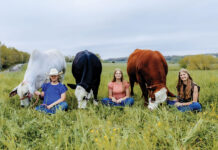
Randall Pemberton grew up around the cattle business. His dad, Duane, has been in the business of buying cattle for 50 years and Randall said, “I just came in and started helping.”
Now Randall has been buying livestock for feedlots for 30 years. He stated, “I enjoy it. I grew up in it, had the love for it, and stayed in it.”
Near Richland, Mo., in Camden County, he has a 950-acre farm and runs a cow/calf operation and backgrounds. But two or three days a week you can find Randall at a livestock market. He said, “We buy cattle out of about 10, but we have other buyers.”
He buys for feedlots and farmer feeders. Randall explained, “Farmer feeders in Iowa and Nebraska that are more family operations and smaller than the feedlots. They usually run 300 to 1,000 head compared to the 10,000 and up in the feedlots.”
At livestock markets it is common to see men on the phone. Randall said they are talking to buyers, to truck drivers, and lining up what they’re going to do.
As a buyer, Randall has his orders. The feedlot owner tells him approximately how much to spend. When cattle enter the ring he decides how much he wants to give for those cattle depending on what his orders are.
The size of cattle he buys also depends on what the customers want that day or week. He said, “We more or less buy the bigger cattle – 600 to 800 pounds.”
Buyers are more apt to buy when several are sold at once. According to Randall, “Buyers like larger groups. They’re worth more.” He said that is because they will feed cheaper in the feedlots.
When it comes to bulls, steers or heifers, he said, “Steers are the highest price, but there are feed yards that give orders for all of them.”
As for the number of cattle he buys in a day, Randall said he would get an order for a semi load, and that is 50,000 pounds.
On this particular day, he was buying for three different feedlots – two in Iowa and one in Kansas. But he added, “Things may change before the day is over. Someone may call and want me to start a load.”
Quality and condition of the cattle are two important things Randall looks for. He stated, “In the summertime some cattle have what is called fescue hair, but that’s just this time of year.” He more or less shies away from those cattle because they get too hot.
Besides quality and condition, Randall also takes into consideration whether the cattle are weaned, their shot program and the value of the cattle. He said, “Cattle are worth more if they’ve had two rounds of shots. They’re not as apt to get sick.” The same is true of weaned cattle.
Ask almost anyone at a livestock market and they will tell you that cattle are at record-high prices. Randall said, “They’ve basically been making new highs every week for about six months. Nobody’s seen anything like this.”
He believes it goes back to the shortage of cattle due to the drought over the last few years. The start was the drought in Texas. Randall stated, “It is supply and demand, and there is a shortage.”
Watching the livestock auction is interesting and educational. Everybody has their own way of bidding. Some lift their hand or lift a buyer’s card. Randall taps his chest.
It is not easy to get started as a buyer. He said, “It’s not impossible, but it is hard. The feedlot has to trust your judgment. There’s not much room for error because a load of cattle is worth over $100,000.” He added, “It can be done, but a person would have to put in a lot of time studying cattle and learning the ins and outs of the market.”







